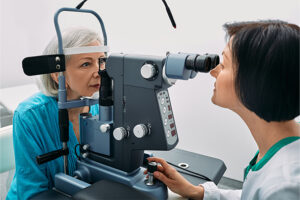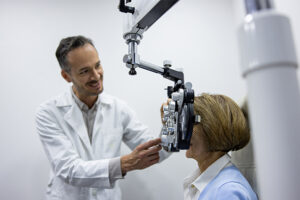Ophthalmology
Neovascular Age-Related Macular Degeneration and Diabetic Macular Edema
Risk of Macular Atrophy After Long-term Intravitreal Anti-VEGF Therapy
Overview
The association between long-term intravitreal anti-VEGF treatment and macular atrophy (MA) in patients with neovascular age-related macular degeneration (nAMD) has been a great catalyst for further research. In the future, a better understanding of neovascularization might lead to new interventions that can rescue the retina from MA.
Expert Commentary
SriniVas R. Sadda, MD, FARVO
|
|
“An interesting topic of debate in the field is whether certain cases of type 1 neovascularization may actually reflect the body's last-ditch effort to try to prevent atrophy. . . . I think that concern about the potential for MA has begun to inform our approach to the treatment of neovascularization.”
We have published a number of papers on this topic, and there is no question that MA is quite common among patients with nAMD who are receiving long-term anti-VEGF therapy. In fact, in clinical trials, we see that the rates of incident MA after 2 years of anti-VEGF are between 20% and 30%. In the SEVEN-UP trial, after approximately 7 years of anti-VEGF treatment, the rates of MA were much higher (ie, in excess of 80%).
Thus, many patients will develop some atrophy. This does not necessarily preclude good visual outcomes in that the fovea may be spared. However, we do want to better understand the underlying causes of MA in individuals treated with anti-VEGF agents. That understanding is still incomplete, but we have been making some interesting observations.
We know that subretinal hyperreflective material is an important risk factor for poor vision outcomes. We also see that patients with a fibrovascular pigment epithelial detachment with an intact retinal pigment epithelium (eg, a type 1 neovascular membrane that has been stabilized, with control of exudation) tend to develop MA and vision loss much less frequently than other patients. An interesting topic of debate in the field is whether certain cases of type 1 neovascularization may actually reflect the body's last-ditch effort to try to prevent atrophy. That is, could this be the body’s attempt to recapitulate a normal choriocapillaris and choroid?
I think that concern about the potential for MA has begun to inform our approach to the treatment of neovascularization. In the past, some ophthalmologists would have aggressively treated with anti-VEGF therapy to try to completely resolve both the exudation and the neovascularization. I think that most ophthalmologists are still in agreement that it is important to eliminate the exudation, but I will not try to completely eliminate the neovascularization if it is type 1. In contrast, if it is type 2 neovascularization, I will absolutely try to eliminate it completely through treatment.
Another important point to highlight pertains to a post hoc analysis of the phase 3 HARBOR trial showing that patients with some subretinal fluid seemed to be less likely to develop MA. The current thinking is that a small amount of subretinal fluid might be an indicator of a type 1 membrane that is still active and capable of supporting the retina and reducing the risk of MA. That said, there are no data to support the suggestion that some fluid may directly be protective against atrophy. It should be noted that in the HARBOR trial, if there was fluid, we did treat it. From my own perspective, I first try to eliminate all of the fluid, if possible. I have concerns that the concept of retinal fluid tolerance could lead to undertreatment and worse long-term visual outcomes in the real world.
Finally, in these studies looking at MA in the context of nAMD, the presence of fluid in the intraretinal space seems to be associated with a higher risk for the development of MA. Some ophthalmologists have suggested that this observation may signal a need for more aggressive treatment; however, it should also be noted that intraretinal cystoid fluid may, in some cases, simply be degenerative. In these cases, an accumulation of fluid may signal that overlying areas are already destined to become atrophic. So, while fluid accumulation is certainly a poor prognostic sign, it is not necessarily an indicator of the need for more aggressive treatment.
When explaining exudation and neovascularization to patients, I will often say that the body had a good idea, but, unfortunately, it was poorly executed. Neovascularization may be a good idea, but its execution is where things go off the rails. In my view, one of the interesting future directions for the field is understanding how to get neovascularization back on track to achieve the intended objective of rescuing the retina.
References
Busbee BG, Ho AC, Brown DM, et al; HARBOR Study Group. Twelve-month efficacy and safety of 0.5 mg or 2.0 mg ranibizumab in patients with subfoveal neovascular age-related macular degeneration. Ophthalmology. 2013;120(5):1046-1056. doi:10.1016/j.ophtha.2012.10.014
Christenbury JG, Phasukkijwatana N, Gilani F, Freund KB, Sadda S, Sarraf D. Progression of macular atrophy in eyes with type 1 neovascularization and age-related macular degeneration receiving long-term intravitreal anti-vascular endothelial growth factor therapy: an optical coherence tomographic angiography analysis. Retina. 2018;38(7):1276-1288. doi:10.1097/IAE.0000000000001766
Comparison of Age-related Macular Degeneration Treatments Trials (CATT) Research Group; Maguire MG, Martin DF, Ying G-S, et al. Five-year outcomes with anti-vascular endothelial growth factor treatment of neovascular age-related macular degeneration: the comparison of age-related macular degeneration treatments trials. Ophthalmology. 2016;123(8):1751-1761. doi:10.1016/j.ophtha.2016.03.045
Li A, Rieveschl NB, Conti FF, et al. Long-term assessment of macular atrophy in patients with age-related macular degeneration receiving anti-vascular endothelial growth factor. Ophthalmol Retina. 2018;2(6):550-557. doi:10.1016/j.oret.2017.10.010
Lukacs R, Schneider M, Nagy ZZ, et al. Seven-year outcomes following intensive anti-vascular endothelial growth factor therapy in patients with exudative age-related macular degeneration. BMC Ophthalmol. 2023;23(1):110. doi:10.1186/s12886-023-02843-2
Mathis T, Holz FG, Sivaprasad S, et al. Characterisation of macular neovascularisation subtypes in age-related macular degeneration to optimise treatment outcomes. Eye (Lond). 2023;37(9):1758-1765. doi:10.1038/s41433-022-02231-y
Rofagha S, Bhisitkul RB, Boyer DS, Sadda SR, Zhang K; SEVEN-UP Study Group. Seven-year outcomes in ranibizumab-treated patients in ANCHOR, MARINA, and HORIZON: a multicenter cohort study (SEVEN-UP). Ophthalmology. 2013;120(11):2292-2299. doi:10.1016/j.ophtha.2013.03.046
Sadda S, Holekamp NM, Sarraf D, et al. Relationship between retinal fluid characteristics and vision in neovascular age-related macular degeneration: HARBOR post hoc analysis. Graefes Arch Clin Exp Ophthalmol. 2022;260(12):3781-3789. doi:10.1007/s00417-022-05716-4
Sadda SR, Guymer R, Monés JM, Tufail A, Jaffe GJ. Anti-vascular endothelial growth factor use and atrophy in neovascular age-related macular degeneration: systematic literature review and expert opinion. Ophthalmology. 2020;127(5):648-659. doi:10.1016/j.ophtha.2019.11.010
Sadda SR, Tuomi LL, Ding B, Fung AE, Hopkins JJ. Macular atrophy in the HARBOR study for neovascular age-related macular degeneration. Ophthalmology. 2018;125(6):878-886. doi:10.1016/j.ophtha.2017.12.026











